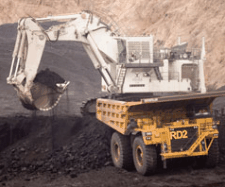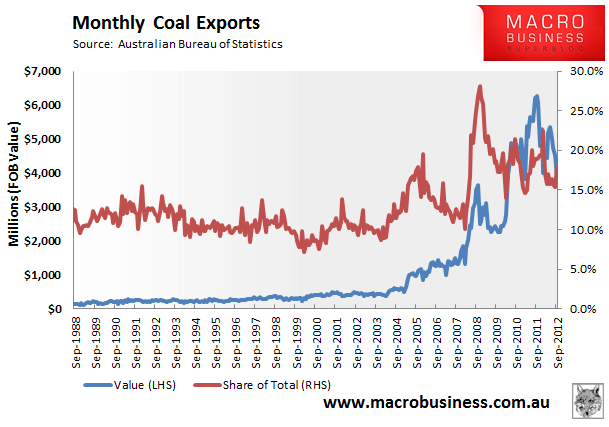
For decades, coal has been a linchpin of Australia’s export base. Prior to the China-led commodity boom, coal exports – both thermal and coking – accounted for between 10% and 15% of Australia’s total merchandise exports. Until late-2009, coal was also Australia’s biggest export commodity, only recently ceding its advantage to iron ore, courtesy of China’s fixed asset investment splurge in the wake of the Global Financial Crisis (GFC).
Despite falling to second place on the export rankings, the value of coal exports, as well as coal’s export share, has grown considerably since 2004, as Australia’s once-in-a-century commodity boom gathered pace.

However, there are reasons to believe that coal’s future is not too bright, as a number of dynamics converge to knock coal of its place amongst Australia’s export elite.
The situation looks particularly worrying for thermal coal, which is exported primarily out of New South Wales’ Hunter Valley and is used for electricity generation. Newcastle thermal coal prices have hit three-year lows, with prices seemingly being crunched by two inter-related dynamics.
First, the shale gas boom in the US has seen significant coal to gas switching in power. As a result, US coal is being redirected into the seaborne market, which is adding to supplies into Asia and depressing prices globally.
According to the Energy Information Administration, the US used 18% less coal for electricity generation in the first half of 2012 than in the same period in 2011, and 27% less than in 2008, which was the year coal consumption peaked. And by March 2012, coal’s share of the US electricity-generation market had fallen 34%, from 47% just three years earlier. All over the US, coal-burning electricity plants are reportedly closing down or converting to natural gas, whose prices had fallen by -56% in the year to April 2012.
The US is the world’s second biggest coal producing nation after China. With coal being displaced domestically by cheaper natural gas, the US is moving to export its excess to the rest of the world, helping to push down coal prices globally. Indeed, US coal exports reportedly rose 56% between 2009 and 2011, according to Businessweek.
Meanwhile, China is rapidly shifting away from coal-fired electricity generation and into renewable energy. Chinese coal-fired electricity production in August 2012 was -7% lower than August 2011. Moreover, Coal’s share of total Chinese electricity production fell from 85% in February 2012 to 73% in August, with the difference made up by renewables.
Rising global supplies and falling demand in China obviously does not auger well for Australia’s thermal coal industry, which is facing significant further reductions in income as well as potential cuts to mine expansion plans, mine output, and employment.
And the fallout from increased gas supplies does not stop there. Natural gas exports – Australia’s fourth biggest export commodity by value (behind iron ore, coal and gold) – are also under threat from low cost US gas. In September, reports emerged claiming that Japan was attempting to sever oil-linked pricing for Japanese liquefied natural gas (LNG) imports.
Oil-linked pricing for Japanese LNG imports began in the 1960s. The gas price was linked to the price of oil because it was the substitute for Japanese power generation at that time. At an oil price of $US100 a barrel, LNG landed in Japan from Australia costs around $US14 per gigajoule.
However, with the LNG price in the US now falling amid the shale gas revolution, and the associated talk of large-scale exports from the US and Africa, the Japanese have sought to end the oil-linked pricing system in order to ease Japan’s soaring energy costs.
The Japanese have a history of making sensible decisions with energy supply, acceding enough pricing power to suppliers to cover the high capital costs of supply development, usually via long-term contracts. The move by the Japanese to break the oil benchmark should be seen, therefore, as an acknowledgement of a developing and long-term gas glut. US domestic shale gas costs around $US3 a gigajoule, around one-fifth of Japanese LNG import prices from Australia.
So, there a number of emerging risks for Australia therefore. Firstly, we risk losing significant export share to North America and Africa. There is also the potential for downward adjustments to existing supply contracts under price review clauses, which could further curtail Australian gas export income. Both of these undermine the assumption that the current mining boom has a “third phase” as net exports drive GDP growth because the investments of today yield high export volume and value growth tomorrow.
Secondly, until recently, the expansion of Australia’s coal and gas industries was viewed as ‘locked-in’, underpinned by a lack of competition in supply from abroad, growing demand from Asia, and, in the case of gas, long-term supply contracts. However, with low-cost supplies emerging in the US and Africa, pricing power is shifting back to the customer. Coal expansions are already swiftly being pared back. But with all the uncertainty surrounding the price outlook for gas, there is an increasing risk that the $180 billion pipeline of planned LNG projects will also erode, jeopardising Australian jobs and growth already under pressure from the coal slump.
Twitter: Leith van Onselen. Leith is the Chief Economist of Macro Investor, Australia’s independent investment newsletter covering trades, stocks, property and yield. Click for a free 21 day trial.

